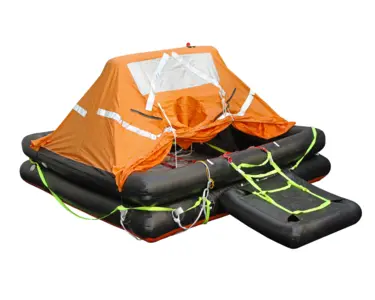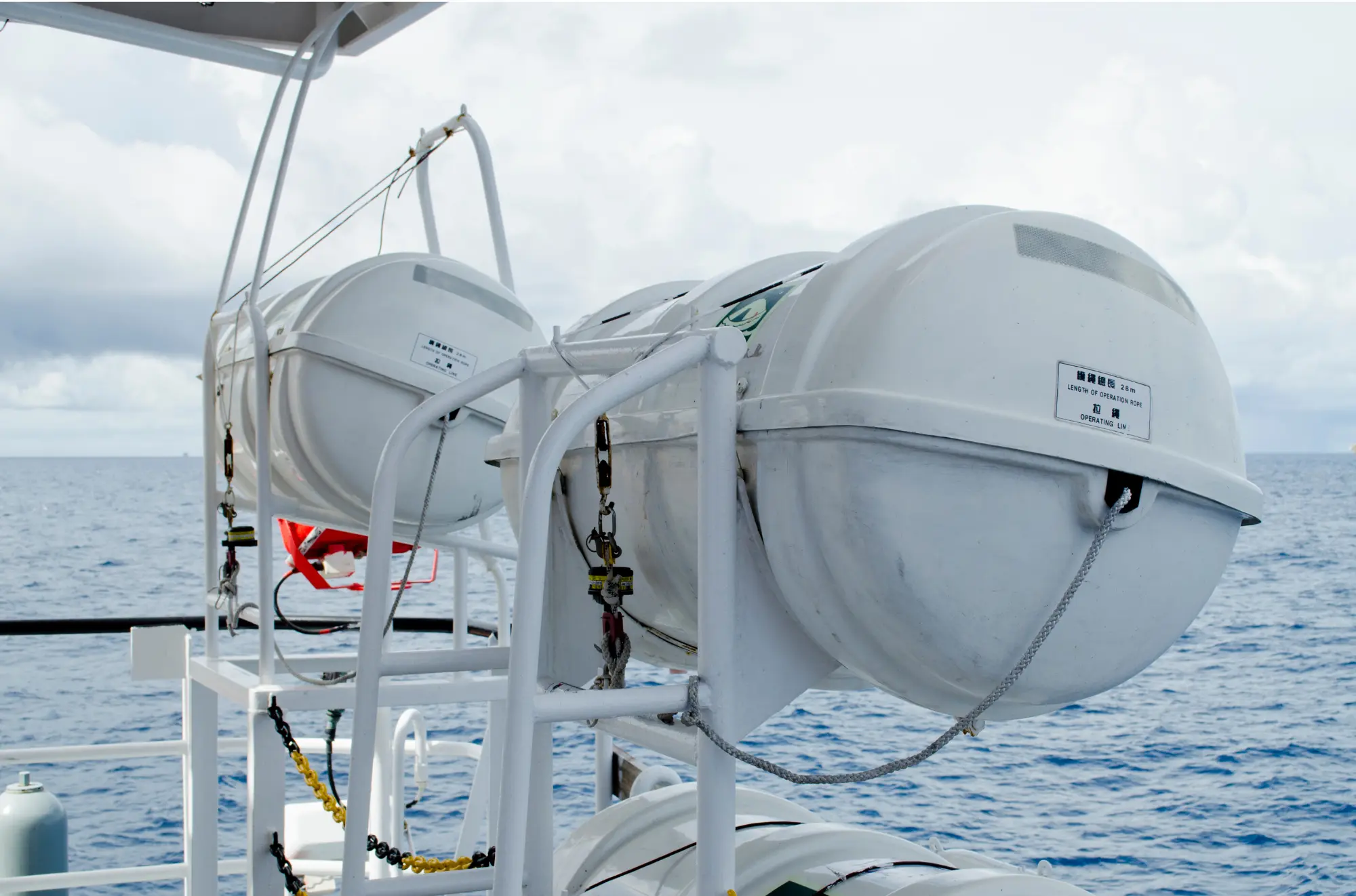Life Rafts: An Offshore Necessity
By Bob Arrington

When is a small boat safer than a big boat? When your big boat is sinking or on fire, and the small boat is your life raft. Recreational boaters too often head out in a mild state of denial that their outing could end in their need to be rescued. Day boaters on inland waters may get away with this, but boaters offshore should carefully think about what it would mean if they had to abandon their boat in an emergency.
Many boaters think only boats crossing oceans or commercial vessels that are required to, carry life rafts. The truth is anyone cruising offshore, even on daily trips, should bring a life raft aboard. Fortunately, life raft manufacturers have made this easy by making rafts suited for any size boat and budget.
In selecting a life raft, first determine what type best fits your needs. It also helps to know a bit about the international certification organizations that certify life rafts. Beside commercial vessels, offshore sailors were the primary customers of rafts, so organizations catering to their needs helped establish testing criteria. All good quality life rafts meet the approval of one or more authorities that test or certify those vessels.
Regardless of which type is chosen, the life raft status and servicing certificate must indicate the standard of approval with which it complies. In addition to the certifying bodies listed below, the U.S. Coast Guard also issues life raft approvals but do so mostly to the Safety of Life At Sea (SOLAS) standard. The primary international organizations are:
• SOLAS (International Convention for the Safety of Life at Sea): These rafts meet stringent standards for important features and durability. They can be stored in fiberglass canisters and have a complete set of provisions. They are built and tested to the International Maritime Organization’s SOLAS Lifesaving Appliances Code. SOLAS life rafts may also be packed and carried in a soft valise, provided the storage complies with appropriate standards.
• ISAF (International Sailing Federation): This organization covers standards for offshore yachting. The life raft specifications are included in ISAF Offshore Special Regulations.
• ISO (International Standards Organization): An international body that issues a variety of industry standards that vary based on the type of life raft and its intended use. For example, ISO compliant life rafts must be capable of withstanding exposure for 30 days afloat in all sea conditions. They must survive being dropped into the water from a height of 18 meters, with the life raft and all equipment still operating satisfactorily. A floating life raft must be able to withstand repeated jumps on it from a height of at least 4.5 meters above its floor, both with and without the canopy inflated.
To help determine what type of raft suits your needs consider the following: For coastal and near coastal cruising, think about an ISO certified life raft where rescue would take place in under 24 hours. For offshore and transoceanic, consider an ISO certified life raft where rescue could be over 24 hours.
The differences between these rafts, among other things will be, the number of air-inflated tubes making up the raft sides, durability of the overhead canopy, whether the raft has an inflatable floor that insulates occupants from cold seawater, and the contents of the survival items packed in the raft. Certifying organizations along with raft manufactures divide rafts into categories, based in part on the distance in miles the primary vessel is used from shore.
Types of emergency survival packs include ISO Pack I, ISO Pack II, SOLAS B Pack, Offshore Pack (Type E), and Coastal Pack. The most complete stocked survival pack is SOLAS A. This pack is meant for vessels operating 50 or more miles from shore, so it includes more water and food provisions. A recreational boater would only select the SOLAS A, because it weighs and costs significantly more than the other packs. Boaters also need to consider the number of persons most likely to be onboard, including pets, and size the raft accordingly.
It’s also important to know that life rafts do not come packed with any type of search and rescue transponders, like EPIRBs, PLBs or VHF radios. This type of equipment would be included in a ditch-bag that the boater would take into the life raft.

CARRY OR MOUNT? IT’S UP TO YOU
After selecting the type of raft to suit your needs, the next very important consideration is where on board the boat the raft is carried or mounted. If the raft is in a soft valise, keep it in a dry, well-protected, yet easily accessible location.
Rafts packed in hard cases with fixed mounts need more consideration when selecting a location, which must allow the raft to float free from your boat in the event of it sinking. Frequently people think this means on top of the boat’s hardtop or a similar upper location. While this may indeed allow the raft to float free, it could also make manually launching the raft difficult, if you needed to abandon a boat that was not immediately sinking.
Think in the case of an onboard fire, where someone needs to launch the raft manually. The raft also must be located where it’s easy to reach and deploy overboard. Medium sized rafts in hard cases could easily weigh 100 pounds or more. Try not to locate the raft where someone would have to lift it and throw it overboard. The ideal location is nested in an outer railing of an upper deck, where it can either float free of a sinking boat or fall free into the water when manually released.
Rafts mounted in hard cases are held to the boat by a hydrostatic release device. If the boat were to sink, when the water pressure reaches a point, typically around eight to 15 feet of water, the device cuts through a cord that holds the raft to the boat. The buoyancy of the container causes the raft to float free from its cradle to the surface.
The life raft is still held to the boat by a breakaway line called a painter, which is attached to a weak link that can break once the raft has inflated. It is very important that the hydrostatic release and weak link are correctly installed. If the painter is not attached to the weak link correctly, the raft may not inflate or release from the sinking vessel.
Most hydrostatic releases have a two-year life, requiring they be replaced at expiration. This is independent from the life raft’s service interval, which varies from one to five years depending on the raft type and brand.
Servicing the raft involves unpacking and inflating the raft, as well as replacing emergency food and water supplies packed into it. Most service/repack facilities allow you to be present when they inflate your raft, and it’s a great idea to coordinate this with them. It’s helpful to be familiar with your raft and its contents in a calm controlled stetting.
Several things on your boat you hope to never use: fire extinguishers, first-aid kits, thru-hull plugs, person overboard devices and your life raft. But having these on board gives you peace of mind, that you and your family would be safe in the event of an emergency.